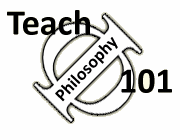Teach Philosophy 101
Free resources for
philosophy teachers!
"One of the most comprehensive, well-researched, and accessible guides for teachers that I have ever seen." James Lang, Chronicle of Higher Education (read full review of TΦ101)
Different Time Perspectives
Another major obstacle is that many faculty members have a different time perspective from that of their students. While faculty members often think in the long-term, many of our students have a short-term orientation. This causes many issues tensions between students and faculty members.
Time Management vs. Time Orientation.
In every college orientation program all of the talk is about how students need to learn time management. Based on the work of legendary Stanford social psychologist Philip Zimbardo, TΦ101 feels that this is a misleading way to frame the issue. First, an anecdote: TΦ101 uses an exam procedure where the students receive, in advance, a large number of short answer questions, some of which will be the subject of questions on the exam. For the class before the test, TΦ101 often makes this announcement, “I will end the class after 20 minutes. You may go if you wish. At that time, I will answer any questions that anyone has about the midterm, so you may stay if you want to have some review for the midterm.” In effect, TΦ101 invites the students to stay if they want to hear the answers to some of the mid-term questions. Predictably, about a third of the students leave the room at that time. They are, of course, the students who will do worst on the test.
This is, however, not a problem about time-management. After all, the students are already there in the class. What is going on is that some students (the ones who stay) say to themselves, “If I stay here for the next half hour, I will do better on the tests.” Other students (the ones who leave) say something to themselves like this. “I am hungry for lunch right now, but the test is not for a few days. I’ll go and get lunch now, and worry about the test when I get there.” The question is not how they manage their time, but which is more important to them – a payoff in the present or a payoff in the future.
Present Orientation vs. Future Orientation
The real issue has to do with what Zimbardo calls “time perspectives.” To simplify Zimbardo’s elegant theory, some individuals are primarily present-oriented. These individuals focus on immediate pleasure and gratification. They are more likely to be aggressive, less likely to wear a watch, and more likely to gamble or seek other short-term gratifications. They also study less, and have less impulse control. Other people are future oriented, and ask themselves what the cost-benefit of certain future actions will be, and they make their choices based on those calculations. Future oriented people are less aggressive, more likely to use a planner, wear a watch, and floss their teeth. They have better impulse control, and study more. For a fascinating discussion of this basic idea, watch Zimbardo himself discuss what he calls the “marshmallow experiment.” In this experiment, young children are given a marshmallow and told that if they can refrain from eating the marshmallow experiment. Most eat the marshmallow, but some are able to delay gratification. The experimenters follow up with the children 14 years later. The children who delayed gratification are remarkably different from those who ate the marshmallow immediately; their SAT scores, for example, are 200 points higher.
These two different perspectives cause many issues between instructors and students, especially with younger students. Most faculty members are future-oriented people who were able to toil away, for example, on a dissertation that would only provide benefits years in the future. Since we are future oriented, we assume that our students will forgo the many immediate pleasures of college life in order to do assignments on which they will not be examined for weeks or months (because that is what we would do). We expect them to write a draft of their paper days before it is due and to study for their exams. Because we are future oriented, this is what we would do. But since many students are more present-oriented, these things are much harder for them. They study only the night before the test, and write their paper in the dawn hours of the day it is due. When the students do these things, we are sometimes frustrated, annoyed, or even angry.
Changing Time Perspectives
Is it possible for students to become more future-oriented? The first step would be for students to analyze their own perspective, by taking the Zimbardo Time Perspective Inventory. This inventory is free and takes only about 20 minutes. Once they know their time perspective, students can choose to work on their particular orientation if they wish. For students who are excessively present oriented, Zimbardo prescribes a number of different exercises, such as practicing delayed gratification, identifying and spending time with other more future oriented students, avoiding alcohol, wearing a watch, and identifying goals for each day. A short video is available on helping younger children modify their time perspective, and it applies to college students in some ways. Some individuals (including students) are overly future-oriented, or overly past oriented. Zimbardo talks a great deal about these individuals as well.
Sources:
Zimbardo, Philip and John Boyd, The Time Paradox: The New Psychology of Time that Will Change your Life (New York: Free Press, 2008).
Zimbardo also lays all of this out in a lecture that he gave at the California Commonwealth Club. A podcast is available from iTunes, and a video version of the lecture is available.
See also Zimbardo's website, where the Zimbardo Time Perspective Inventory is available, as well as clips of Zimbardo talking about the Marshmallow experiment.
Author: John Immerwahr
Update: May 16, 2012
